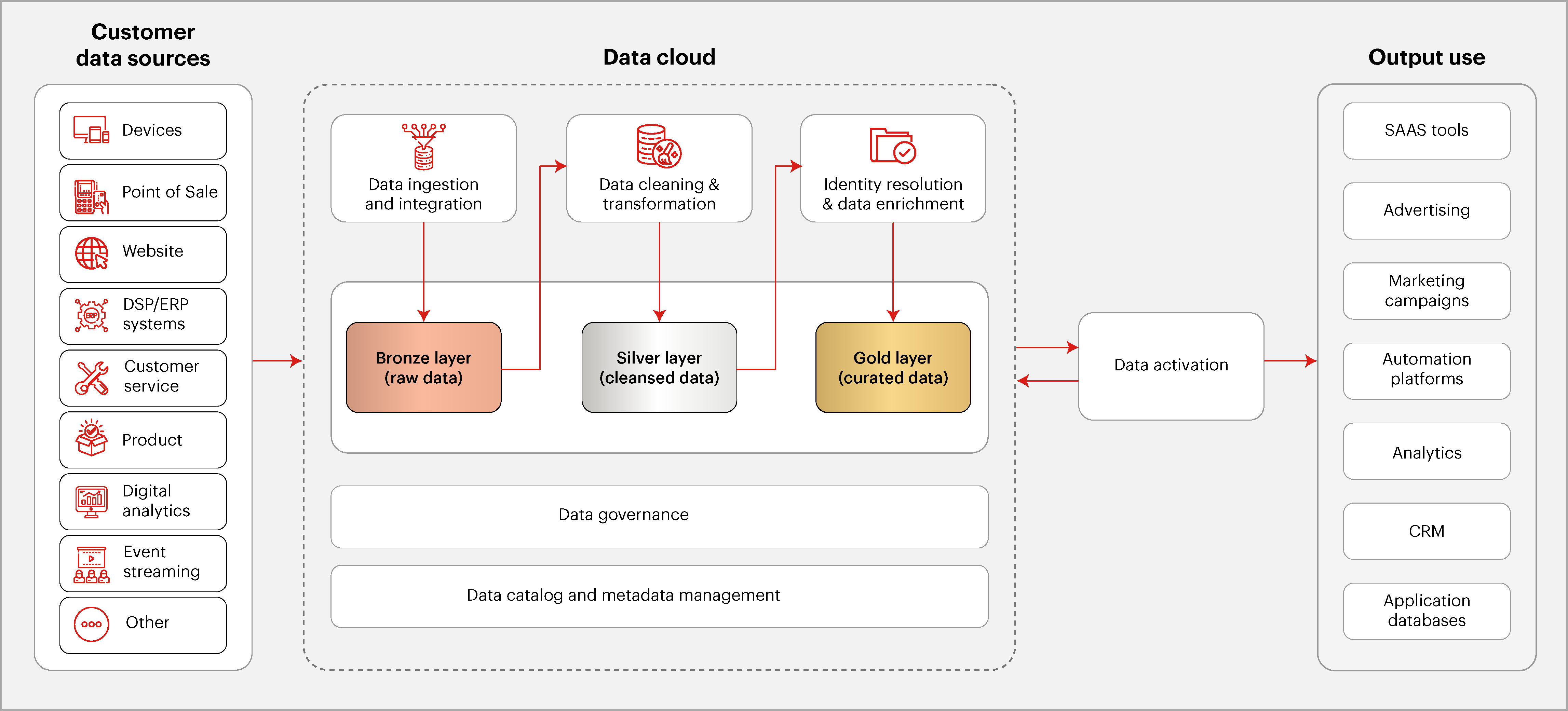Maximizing the impact of customer analytics with composable CDPs
Reading Time: 5 minutes

In recent years, customer data platforms (CDPs) have emerged as indispensable tools in the realm of the MarTech stack. A CDP serves as a centralized system for collecting, organizing, and analyzing customer data from diverse sources to create comprehensive customer profiles. These profiles are leveraged by various analytics, automation, CRM, and activation tools to enable personalized marketing activities, advanced data analytics, predictive capabilities, etc.
These platforms play a vital role in creating audience segments, aggregating customer data from multiple sources, and activating this data across multiple touchpoints throughout the buyer journey. Customer-driven marketing requires a CDP that integrates customer data with the full breadth of enterprise data, enabling advanced use cases and delivering superior customer experiences in a cost-efficient manner.
Building a data foundation for CDP-based customer analytics
A robust data foundation is imperative to ensure the success of CDP implementations and overcome challenges related to siloed data and privacy regulations. A scalable data foundation empowers enterprises to extract actionable insights from vast amounts of customer data, unlocking its true potential. The data foundation serves as the bedrock for modern CDPs, allowing enterprises to:
- Unify disparate customer data: From purchase history and social media interactions to website behavior, a data foundation integrates various data sources into a unified view of the customer.
- Gain deeper customer understanding: Centralized data analysis leads to insights into customer preferences, buying behavior, and pain points, facilitating more effective marketing campaigns and product development strategies.
- Drive data-driven decision-making: Accurate and accessible customer insights enable informed decisions across pricing, promotions, product innovation, and personalized experiences.
Composable CDPs enable customer analytics with centralized data lakes
Composable CDPs enable more agile and effective customer analytics initiatives by focusing on the right data, integrating new data sources and tools as businesses evolve, and ensuring their data foundation remains future-proof and effective. It also connects data to activation channels, enabling the marketing/customer teams to take the right action based on customer insights.

Fig. 1. Logical CDP dataflow architecture of a composable CDP (Image adapted from AWS)
Components of a composable CDP:
- Data collection: Identify and ingest customer data from multiple sources and across mobile, web, analytics, and digital applications using identifiers such as emails or device IDs, as well as demographic or psychographic information. For first-party data, CDPs collect digital behavioral data (e.g., clicks, page views, etc.) in real-time. For third-party data, such as CRM, POS data, or streaming event data, products that specialize in ELT pipelines with built-in integrations across a wide range of SaaS platforms.
- Identity resolution: Post data ingestion, the data needs to be cleaned and modeled correctly to minimize noise for subsequent processes. BI or data transformation tools enable data analysts to prepare tables within the data warehouses, facilitating sharing across multiple teams. A shared modeling layer simplifies the identification of each customer and resolution of duplicate entities.
- Data storage: The storage and compute layer acts as the source of truth for the raw, cleansed, and curated customer data. In a composable CDP, data storage is provided by a cloud data warehouse with a customer 360, that is owned and managed by the user organization. Customer 360 stores and enables data enrichment to create a comprehensive and unified view of a customer.
- Data activation: This is the stage where non-technical business teams (i.e., marketing, sales, service, support, etc.) access the stored and modeled customer data from a central repository and activate it to channels or applications used by internal teams.
There are many off-the-shelf CDPs available in the market to fit unique business needs such as Twilio Segment, Salesforce data cloud, SAP CDP, Adobe Realtime CDP, BlueConic, Hightouch, Action IQ, Amperity, Epsilon, etc. that can help manage and store all their data on a centralized platform and allow users to easily access data as per their usage. However, a trusted data and analytics partner can help choose the right tool or customize models to achieve various marketing goals.
CDPs are an extension of the data management strategy
Composable CDPs are not a stand-alone solution but rather a key component that integrates with your existing data infrastructure and workflows. The modular architecture approach of a composable CDP emphasizes the ability to build systems with independent, reusable data management and customer engagement components/ or services/tools. It is built to leverage the existing single source of truth in an organization’s data lakehouse/data cloud, minimize data replication, and easily put together all the customer data from multiple sources and touchpoints to create a comprehensive customer 360.
By aligning the CDP with your broader data management strategy, you can maximize the value of your customer data:
-
- Data mesh aligns with CDPs by empowering domain teams to own and manage specific customer data independently. This fosters agility, allowing businesses to adapt to evolving customer needs and market demands faster.
- Data mesh principles can help scale CDP implementations by breaking down large customer datasets into manageable domains. This allows businesses to handle the volume of data effectively and distribute the workload across teams.
- Customer analytics teams can collaborate with domain teams within the data mesh framework. This ensures that the customer data is accurate, secure, and compliant at any point in time.
Conclusion
Customer-facing enterprises can gain breakthrough levels of customer insight from composable CDPs in a way that easily shares that insight across the enterprise, delivers granular reporting, and boosts marketing productivity. Succeeding with customer data is only possible with a robust data foundation supported by a CDP with modular architecture–allowing enterprises to choose the best tools according to specific goals, and business requirements while optimizing costs across a variety of use cases. The data foundation in the CDP empowers enterprise leaders by providing them with the right views to take correct action across the customer journey.
About the Author
Nandam Karthik is a Principal Architect at Sigmoid with 10+ years of experience as a full stack engineer and big data technologies from designing end-to-end data management solutions to delivering turnkey analytics projects for Fortune 500 companies. He is passionate about solving business problems for enterprises across CPG, Retail, QSR, and Financial services through his expertise using open-source and cloud technologies
Featured blogs
Subscribe to get latest insights
Talk to our experts
Get the best ROI with Sigmoid’s services in data engineering and AI
Featured blogs
Talk to our experts
Get the best ROI with Sigmoid’s services in data engineering and AI






